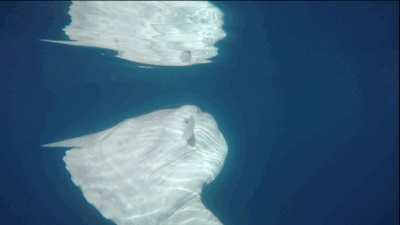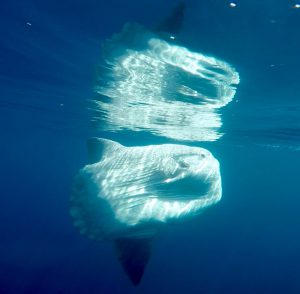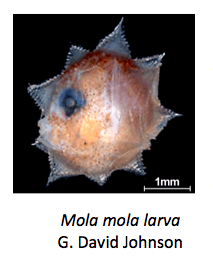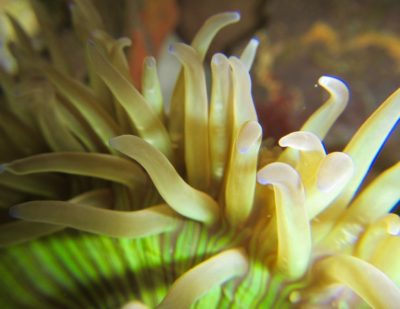
 Mola Molas are definitely one of the strangest looking fish found in our oceans. Molas got their name due to the very distinct shape of their body, in Latin the word Mola means “millstone.” They have a very rounded body with very pronounced dorsal and anal fins.
Mola Molas are definitely one of the strangest looking fish found in our oceans. Molas got their name due to the very distinct shape of their body, in Latin the word Mola means “millstone.” They have a very rounded body with very pronounced dorsal and anal fins.
An average adult Mola will reach about 6 feet from snout to tail and about 7 feet from the tips of the dorsal and anal fins. They also weigh an average of about 2,200 pounds however some molas have even been documented weighing in at a massive 5,000 pounds making them the heaviest of all bony fish!
Nicknamed the ocean sunfish these enormous fish are frequently seen basking in the sunlight near the surface. Because Molas lack a swim bladder, have a very thick layer of low-density gelatinous tissue under their skin, as well as a degenerate cartilaginous skeleton they are neutrally buoyant in the water. This allows Molas to move with ease both horizontally and vertically in the water column.
Molas utilize both their dorsal and anal fins as their primary way of locomotion – they essentially use these fins as a pair wings. Although they may look like slow awkward swimmers it has been documented that the combination of their “wings” allow them to swim long distances, dive to incredible depths, breach out of the water, and even swim up to speeds of almost 0.4 to 0.7 meters per second! How insane is that!
 Because these fish can get up to such a massive size females produce more eggs than any other vertebrate on our earth. It is estimated that females carry more than 300 million eggs! Molas are in a spiky star-shape when they are first born giving planktonic Mola larva extra protection during their first few weeks. As they continue to grow larger and stronger these spikes begin to disappear. During their first year it is estimated that Molas will gain an average of 2 pounds per day. The Monterey Bay Aquarium once observed a Mola that gained about 822 pounds in just 15 months. So what do these awesome fish eat in order to get to such large sizes?
Because these fish can get up to such a massive size females produce more eggs than any other vertebrate on our earth. It is estimated that females carry more than 300 million eggs! Molas are in a spiky star-shape when they are first born giving planktonic Mola larva extra protection during their first few weeks. As they continue to grow larger and stronger these spikes begin to disappear. During their first year it is estimated that Molas will gain an average of 2 pounds per day. The Monterey Bay Aquarium once observed a Mola that gained about 822 pounds in just 15 months. So what do these awesome fish eat in order to get to such large sizes?
A Mola’s favorite snack are the gelatinous zooplankton that drift with the ocean currents. In particular they love to prey upon jellies, Portuguese man-o-war, by-the-wind sailors, as well as salps.
Ocean sunfish love to bask at the surface of the water to thermoregulate as well as catch prey. However they also chill in the surface of the water for another extremely important reason. Overtime Molas become infested with tons of parasites. More than 50 species of parasites have been documented both on and within molas. In order to combat these pesky parasites, molas have formed symbiotic relationships with cleaner fish and even birds. Some have even been documented breaching 10 feet out of the air, landing on the surface with a forceful splash in hopes of removing these parasites.

Written By: Alex Feltes
Sources:
Leisher, Craig. Mola Mola: The Weirdest Fish in the Ocean? Cool Green Science. 2014
Love, Milton S. Mola Mola. Certainly More than You Want to Know About the Fishes of the Pacific Coast. 2011.


